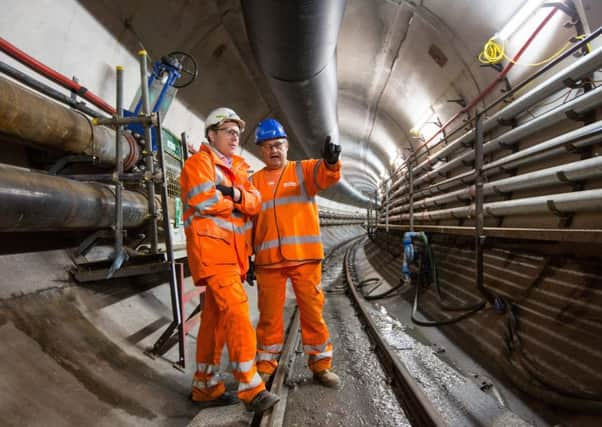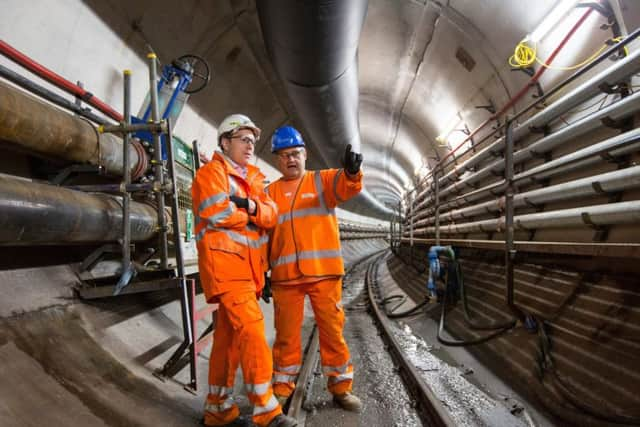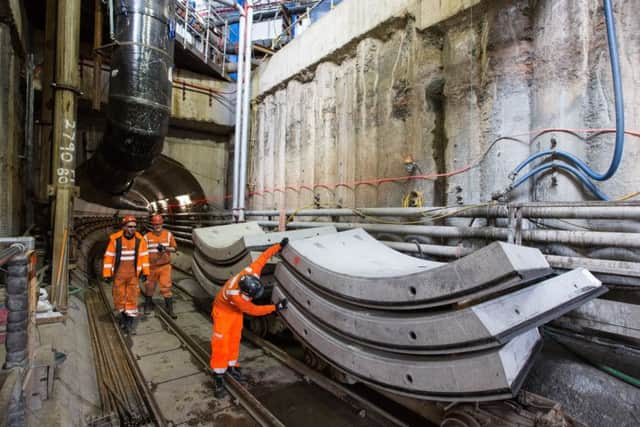Shieldhall: Intrepid tunnellers save Glasgow from floods


He’s been working in the dark since the age of 15, first in the Warwickshire mines, like his father, then in a series of railway and water tunnels across Europe.
The 56-year-old is tunnel works manager on the Shieldhall Tunnel beneath Glasgow, which will act as a giant water tank to reduce flooding across the south side of the city and pollution of the River Clyde.
Advertisement
Hide AdAdvertisement
Hide AdScottish Water’s £100 million project will also pave the way for housing and commercial developments to go ahead that have been held back by the lack of waste water capacity.
The 3.1-mile concrete tube will stretch from Queen’s Park to the Shieldhall waste water treatment works beside the Queen Elizabeth University Hospital.
It will provide a huge amount of extra capacity for the overstretched drainage system – the equivalent of 27 Olympic swimming pools of water.
The tunnel is needed because after a deluge of heavy rain, an increasingly frequent occurrence because of climate change, water backs up in the system and floods houses and businesses.
The 15ft diameter tunnel – big enough for the proverbial double-decker bus – will also help prevent such surges of extra water overwhelming the treatment works. These can displace untreated sewage, which then spills into the Clyde, killing fish and harming the wider marine environment.


The tunnel will operate in conjunction with the current sewage pipes, which handle 80 per cent of the south side’s drainage but are half its diameter. These flow north-west under Pollokshields and beside the M8 to the Shieldhall works.
The project is a massive undertaking, involving the building of a railway inside the tunnel to take workers to the tunnel boring machine (TBM) at its head, which is twice the length of a football pitch.
Daisy – TBMs are always given female names – has been burrowing her way eastwards from the tunnel mouth in Craigton, south of Govan, at the rate of about an inch a minute.
Advertisement
Hide AdAdvertisement
Hide AdSince being launched, ship-style, by smashing a bottle of water from Loch Katrine, which supplies Glasgow, she has been in action for a year, working round the clock five days a week, and is now under Titwood Road in Crossmyloof.


That’s three-quarters of the way to Queen’s Park, where the TBM is expected to break through a wall into a huge open chamber the depth of a five-storey building in October.
A new 260ft long pipe will then connect the tunnel to the existing sewer, and water should start flowing along it by next April or May.
For the tunnellers, who do 12-hour shifts on the TBM, there is only one way in and one way out – a 30-minute train ride over more than two miles from the tunnel mouth aboard a rudimentary carriage, which is still called by its somewhat outdated name of “man rider”.
There are only ten women, including engineers, in the workforce of 170. None of them work in the tunnel, despite the TBM being “female”.


The 14-seat mud-splattered coach forms part of three battery-powered freight trains, which also take wagons of pipes, grout, concrete slabs and more rails to the ever more remote end of the line.
The signalling system includes rope lights strung along the tunnel walls which change colour from blue to green to red to show which way trains are coming. “It’s a disco down there,” one worker joked.
Tunnellers do alternative day and night shifts starting at 7am and 7pm, with work suspended at the weekend to give them a chance to rest and for the TBM to be maintained.
Advertisement
Hide AdAdvertisement
Hide AdSafety measures are exhaustive. Anyone going into the tunnel has to pass through a hand-recognition security turnstile and must carry a mini breathing apparatus set in case of fire or other emergencies.
They are also given a numbered brass “tally” to wear as part of a system that has been used in mines for more than a century. Chillingly, it enables a person to be identified when all that is left of them after a fire is the metal disc. A silver disc with the same number is kept on a “tally board”, so it’s known who’s in the tunnel.
Only 24 people are allowed in the tunnel at once, because that’s the capacity of a refuge chamber in the TBM, which has enough oxygen for 24 hours.


There are fire extinguishers along the tunnel, and waterfall-like “water curtains” every 500m, which are activated to prevent smoke spreading. There are also detectors for explosive gases such as methane, but none has been found.
For the aptly named Burrows, a former TBM driver, attitudes to safety have been transformed during his 43-year tunnelling career.
“Health and safety has improved incredibly. I have worked with some absolute bastards in my life – it has changed beyond belief. Before, we were just cannon fodder.”
It is a world away from the construction of the Clyde Tunnel in the early 1960s – which is just a fifth as long – in which two workers died and others suffered decompression sickness.
However, for some Shieldhall tunnellers, the most important safety feature is a small statuette in a wooden case at the tunnel mouth. Saint Barbara is the patron saint of tunnellers and miners because of their use of explosives and her association with lightning. Traditionally, a shrine to the saint is placed at the tunnel portal before digging starts. Shieldhall’s Barbara, who was brought by some of the French tunnellers on the project, shares her glass-fronted box with some paperwork. Should her powers fail, mounted on the wall beside the case is a more modern way of calling for help – a phone.
Advertisement
Hide AdAdvertisement
Hide AdWhen the project is finished, the effigy will go with the tunnellers – from the VINCI Construction Grands Projets and Costain joint venture doing the work – to their next job.
Burrows expects to be heading for the Thames Tideway Tunnel, a major new sewer in London. “There’s a lot of camaraderie in tunnelling,” he said. “I will know 70 per cent of the labour force.
“There is a challenge every day, but it’s enjoyable and there’s a sense of achievement. It’s a hard life, but we’re well rewarded.”
Experienced tunnellers can earn around £500 a day, or well over £100,000 a year.
But at Shieldhall, the job is far more complex than simply driving the German-built TBM through the ground from A to B. For a start, the machine doesn’t know where it is, since GPS doesn’t work underground, with co-ordinates having to be fed in from the project base.
The tunnel route has unusually tricky geological conditions, while it also has to maintain a gradual descent so water follows gravity.
On top of that, the route is deliberately indirect to increase the tunnel’s water-holding capacity, curving round the top of Pollok Park. And it had to be designed to avoid as many homes as possible.
Everything from clay, boulders and sandstone to a “soup” of looser material has been encountered. Only so much can be predicted from the bore holes sunk every 330ft along the route.
Advertisement
Hide AdAdvertisement
Hide AdThat compares to the “very consistent” geology of tunnels such as Crossrail’s in London, according to Shieldhall’s 37-year-old project manager, Dominic Flanagan.
The Shieldhall Tunnel is up to 130ft deep, with obstacles including the Glasgow-Paisley Canal rail line, which had to be shut for a weekend while the TBM passed just 13ft beneath.
With three-quarters of a mile left to go, the next big test will come this week, when the TBM crosses under another rail line near Crossmyloof Station.
Trains have already been slowed to 20mph as a precaution.
Old coal mine workings in the tunnel’s path have been found to be so extensive that more grout has had to be pumped in to stabilise them than was used to shore up coalfields crossed by the Borders Railway in Midlothian.
As for disturbance, the tunnel mainly follows the line of streets as well as crossing three parks, and goes under just two houses.
“People hopefully don’t know we are down here,” said Burrows. “If they do, we are in trouble.”
Flanagan said digging under homes had been avoided because it had not become the accepted practice in Glasgow that it was in London.
There have only been two damage incidents, one to the garden behind a house in Titwood Road when slurry – clay and water – that was being pumped under pressure forced its way out of the ground through a fault in the rock.
Advertisement
Hide AdAdvertisement
Hide AdThe other affected part of Haggs Castle golf course beside Pollok Park.
However, traffic diversions from the year-long closure of part of Queen’s Drive and Langside Road, beside Queen’s Park, have been extended by four months to September because of complications with creating connections between the tunnel and existing sewers.
But despite that delay, Scottish Water has dismissed reports last week that the project was running late.
All the material excavate – which will total 250,000 tonnes – is pumped through pipes along the tunnel to Craigton, where it is sorted in a complex spoil treatment plant.
Curved concrete segments, each weighing 2.5 tonnes, are then fitted into place to form the tunnel wall, with 18,000 in all to be installed along its length.
When finished, all the pipes and cables supplying the TBM will simply be stripped out, along with the railway tracks, and water allowed to pour in.
Then it will be fingers crossed for the residents of flood-prone homes around Hampden Park and in Mount Florida, Toryglen and Giffnock when the next downpour comes. “It should substantially reduce the risk,” said Flanagan.
As for the huge chamber where the tunnel will be joined to the sewers in Queen’s Park, most of those playing on the cricket, football and basketball pitches and courts to be built over it won’t notice it’s there, 66ft below them.
Advertisement
Hide AdAdvertisement
Hide AdBut for the engineers working in the shaft – and in a second one nearby – it’s just like with the tunnel: there’s only one way in and out.
In this case, it’s a four-person metal cage on a crane – a “man-riding basket” – in case you hadn’t already guessed that.
“If they need the toilet we send the basket down,” said general foreman Simon Taylor, 42. “But if we are tight for time, we don’t send the basket right away,” he added, tongue in cheek.
As for spending your day at the bottom of what’s effectively a massive concrete pit, at the mercy of a crane driver for the sole means of escape, he said: “I don’t think it’s for everybody, but the guys who do it are good at their job.”
Taylor, though not a tunneller, is also part of the travelling construction industry workforce. Originally from Glasgow and living in Ayrshire, he’s managed to find jobs that have kept him close to home, from completing the M80 to working on the Braehead and Glasgow Fort shopping centres. Where next? “Spin the wheel and see where it stops,” he said.
The tunnel is the first stage of a £250m upgrade across Glasgow. “We are dealing with a Victorian system built more than 100 years ago,” said Flanagan. “The network has not kept pace with growth up above, but people just expect it to be there. It does not future-proof it, but brings us into the 21st century.”
The tunnel has been a long time coming – 15 years after the first concerted moves were made to tackle Glasgow’s flood problem.
Major flooding in July 2002 after the city’s average monthly rainfall fell in ten hours led to the formation of the Metropolitan Glasgow Strategic Drainage Partnership involving public bodies such as local authorities, Scottish Water, the Scottish Environment Protection Agency and Scottish Canals.
Advertisement
Hide AdAdvertisement
Hide AdTen years later, the tunnel was decided upon, while Flanagan has been involved in preparations since 2011.
He said other such tunnels are not currently on the cards as the network north of the Clyde is not so congested, but he said other major improvements will be required in Aberdeen, Edinburgh and Dundee, as well as Glasgow.